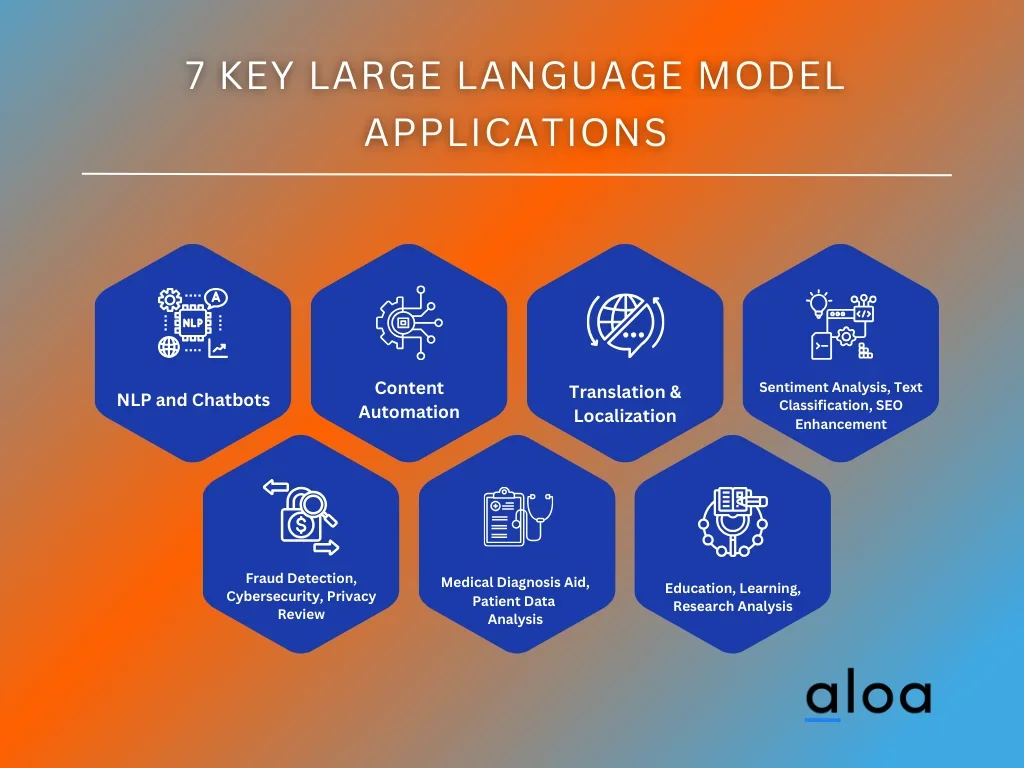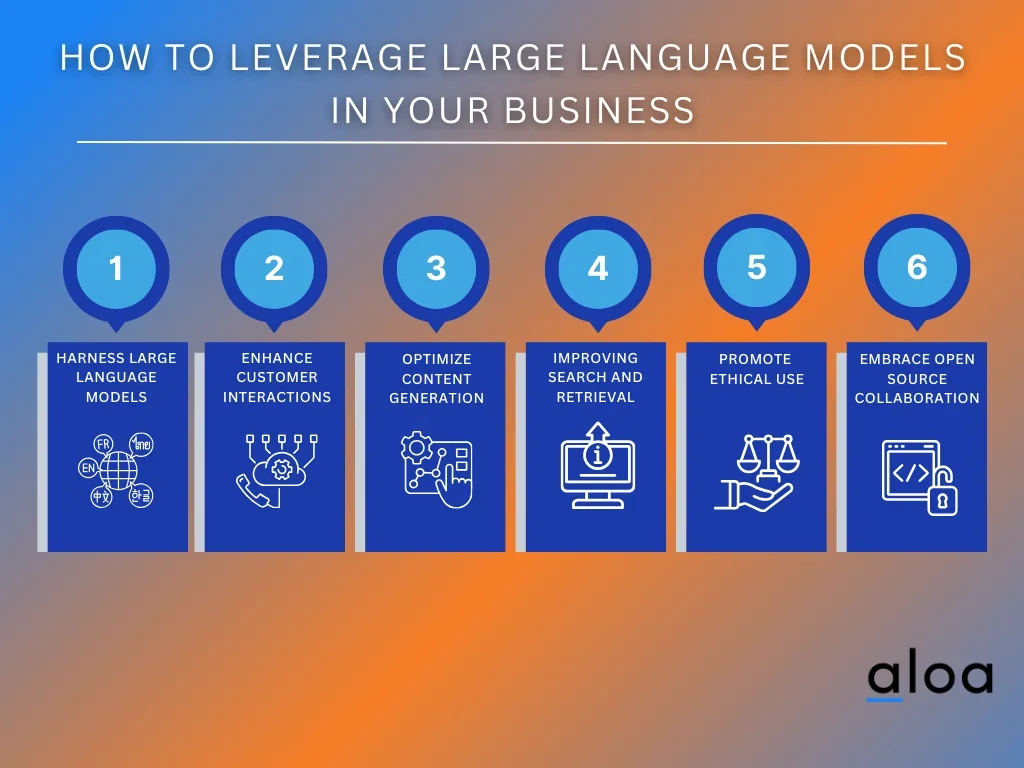Large language model applications have revolutionized the way businesses and startups operate. Their importance has grown exponentially in recent years due to rapid advancements in artificial intelligence (AI), particularly in machine learning.
Aloa provides invaluable assistance to businesses seeking to harness the potential of large language model applications. By harnessing cutting-edge AI technology, Aloa aids in the development of versatile applications that cover a broad spectrum of use cases, ranging from natural language comprehension and chatbots to content generation and data analysis.
This blog examines the wide-ranging applications of large language models and emphasizes their crucial role in various industries. These powerful models have dramatically transformed traditional processes by offering innovative solutions and enhancing human capabilities.
They support customers with chatbots, improve financial trading algorithms, optimize marketing strategies, aid healthcare diagnostics, and more. Thanks to these advances, industries across the board have benefited from improved efficiency and effectiveness.
By the end of this blog, you will gain a comprehensive understanding of how the integration of large language models is shaping business and startups in 2024. We will also explore the ethical considerations and challenges that arise with their use, emphasizing the importance of responsible AI deployment in this era of rapid technological advancements.
Let's dive in!
7 Key Large Language Model Applications
Large language models (LLMs) have transformed the way we engage with machines and navigate the information-driven world. In this comprehensive exploration, let us delve into several large language model applications, shedding light on their significance, real-world implications, and transformative potential.

1. Natural Language Processing and Chatbots
Natural Language Processing (NLP), a subset of artificial intelligence, has long been pursued as the holy grail in technology. Its primary objective is to empower machines with the ability to understand, interpret, and generate human language in a manner that feels natural and coherent. The emergence of significant language models like OpenAI's GPT-3 has propelled NLP towards achieving this ambitious goal.
NLP in Customer Service
One of the most significant uses of large language models is customer service. These models enable chatbots to have natural and meaningful conversations with customers, revolutionizing the customer support landscape. They provide instant responses and assistance, regardless of query volume or time constraints. From troubleshooting technical issues to providing product recommendations, these chatbots excel at handling varied inquiries.
Chatbots
OpenAI's ChatGPT represents a remarkable instance of a sophisticated language model created to enable conversations resembling those with humans. It presents an accessible and adaptable solution for businesses interested in integrating conversational AI into their operations. With the assistance of ChatGPT, companies can develop virtual assistants capable of addressing inquiries, providing information, and engaging users through interactive exchanges.
2. Content Generation and Automation
In our modern era, where there is an insatiable demand for high-quality content, the emergence of large language models has proven to be a game-changer. These models have not only made the content generation more efficient but also remarkably versatile.
Automated Content Creation
These models have exceptional capabilities for generating various types of content. They effortlessly produce blog posts, product descriptions, marketing copy, and news articles. With just a topic or a brief input, these models swiftly produce coherent and contextually relevant text. Businesses are embracing the power of large language models to automate content creation, leading to cost reduction and time savings. Media outlets are particularly benefited by the ability to generate real-time news articles based on breaking news—a genuinely transformative development.
Code Generation
Code generation is another remarkable application of large language models. These models have the ability to generate code snippets, making software development and programming tasks more straightforward. They can write Python code, HTML, and various other programming languages, significantly speeding up the development process. By utilizing these models, software developers can automate repetitive coding tasks. This automation provides them with more time to devote towards innovation and creative problem-solving.
3. Language Translation and Localization
The goal of breaking down language barriers has long been pursued in our increasingly interconnected world. Remarkable progress is being made through the utilization of large language models.
Machine Translation
Language models have made remarkable strides in the realm of machine translation, making it effortless for users to convert text across different languages seamlessly. These advancements hold considerable significance for global enterprises and international communication. Whether it's a website, document, or real-time conversation needing translation, these sophisticated language models are effectively bridging linguistic barriers.
Localization
Large language models go beyond translation and play a crucial role in localization efforts. Localization involves adapting content and applications to specific cultural contexts, allowing businesses to connect with their global target audiences. These models can effectively identify culturally sensitive content, accurately translate idiomatic expressions, and customize user interfaces according to regional preferences.
4. Sentiment Analysis, Text Classification, and SEO Improvement
Understanding and accurately classifying the sentiment behind text plays a crucial role for businesses aiming to gauge public opinion and enhance their online presence.
Sentiment Analysis
Large language models have a remarkable ability in sentiment analysis. This involves discerning whether a piece of text conveys positive, negative, or neutral sentiment. Language models with their exceptional prowess provide invaluable assistance to businesses in gauging public sentiment towards their products, services, or brands. By closely examining social media posts, customer reviews, and news articles, these language models offer crucial insights that help companies refine their strategies and effectively respond to customer feedback.
Text Classification
Text classification tasks, such as categorizing support tickets, news articles, or social media posts, also reap the benefits of utilizing advanced language models with exceptional classification capabilities. These models can automatically classify vast amounts of text, providing businesses with a seamless mechanism for organizing and prioritizing information effectively. For example, companies can leverage these models to effortlessly assign customer support tickets to the most relevant teams based on the nature of each inquiry.
SEO Improvement
Search Engine Optimization (SEO) is vital in boosting online visibility. To enhance SEO, the use of large language models proves beneficial. These models offer suggestions for keywords, generate SEO-friendly content, and optimize webpages to cater to search engine requirements. By analyzing search trends and providing recommendations based on popular queries, they aid in creating high-ranking content that aligns with user searches.
5. Fraud Detection, Cybersecurity, and Privacy Policy Analysis
During this digital age marked by escalating cyber threats, the role of significant language models has become vital in strengthening cybersecurity measures and safeguarding user privacy.
Fraud Detection and Cybersecurity
Cybercriminals are constantly developing new tactics, which pose a challenge for detecting fraud. Large language models come into play to address this issue by analyzing data patterns and user behavior to identify fraudulent activities. These models assist businesses and financial institutions safeguard themselves and their customers from potential financial harm. By flagging suspicious transactions, login attempts, or any irregularities, they enhance overall security measures.
Privacy Policy Analysis
Individuals often find the task of reviewing privacy policies and terms of service agreements to be tedious and time-consuming. However, with the assistance of large language models, these documents can be parsed and summarized effectively. By providing concise explanations of complex legal language, users are empowered to make informed decisions about their data privacy and online interactions.
6. Medical Diagnosis Assistance and Patient Data Analysis
The healthcare sector is undergoing a profound transformation fuelled by the advances in large language models. These models have specifically revolutionized medical diagnosis and patient care, making way for significant improvements and progress.
Medical Diagnosis Assistance
These models offer valuable assistance to medical professionals. They analyze patient data, symptoms, and medical literature to suggest potential diagnoses and treatment options. For instance, a large language model evaluates a patient's medical history, current symptoms, and relevant medical research. It then provides doctors with a curated list of potential diagnoses. This invaluable tool enables healthcare providers to make well-informed decisions that enhance patient outcomes.
Patient Data Analysis
The healthcare industry generates extensive amounts of patient data, encompassing electronic health records (EHRs) and medical imaging data. Analysts can use large language models to extract valuable insights and identify trends from this invaluable data. These insights can then be harnessed by healthcare providers to optimize resource allocation, advance medical research, and enhance patient care.
7. Education, Learning, and Research Analysis
The impact of large language models extends to education, learning, and research.
Education and Learning
Large language models can function as virtual tutors, providing personalized learning experiences for students. They possess the capacity to respond to queries, elucidate intricate concepts, and offer educational materials that are tailored to meet individual needs. This personalized approach to education fosters improved learning outcomes while ensuring accessibility to a broader array of learners.
Research Analysis
Researchers from various disciplines utilize large language models for analyzing extensive datasets, conducting comprehensive literature reviews, and generating concise summaries. These models significantly expedite the research process by efficiently sifting through vast amounts of information. They effectively identify valuable findings and insights, making them invaluable tools for researchers engaged in market research analysis, customer review summarization, or sentiment analysis on social media data.
Ethical Considerations and Challenges in Using Large Language Models
Large language models possess undeniable power, but their deployment raises significant ethical considerations and challenges. Let’s explore the critical issues stemming from the integration of these models into various applications.

Addressing Bias and Ensuring Fairness
When using large language models, one of the main concerns is the potential for bias in their outputs. These models learn from extensive datasets from the internet, which may contain biases. When these biases find their way into the generated text, they can reinforce stereotypes and perpetuate inequalities.
To address bias, developers must carefully select and process training data. Ongoing monitoring and fine-tuning are also critical to ensure fairness. It is essential to implement measures that can detect and rectify biased outputs to uphold ethical standards within large language model applications.
Protecting Privacy and Data
Large language models need access to extensive amounts of text data for their training, a requirement that brings about privacy concerns, mainly when dealing with sensitive or confidential information. The protection of user data and adherence to data protection regulations are essential in this context.
Companies and organizations that utilize these models must prioritize implementing robust data security measures. It is crucial to ensure the protection of privacy and data integrity through anonymizing and encrypting data, controlling access to authorized personnel, and regularly auditing data handling processes.
Accountability and Responsibility in Model Use
The responsibility of using large language models ethically and responsibly accompanies their immense power. When developers and organizations utilize these models, they must establish clear guidelines and principles. This includes defining the limits of model capabilities and the ethical boundaries within which they should operate.
In addition, it is crucial to prioritize transparency when deploying models. It becomes imperative to keep users and stakeholders well-informed about using extensive language models and any potential consequences that may affect them. To address ethical breaches and unintended outcomes, implementing accountability mechanisms is equally necessary.
Addressing Misinformation and Dual Use Concerns
The rapid generation of text that imitates human language by large language models raises concerns about misinformation and potential misuse. While these models promise positive applications, they can also be exploited to spread false information or enable cyberattacks.
To effectively achieve these objectives, close collaboration is required among developers, policymakers, and regulators. By working together, they can strike a balance between promoting innovation while safeguarding against possible harm caused by misleading information.
How to Leverage Large Language Models In Your Business
Large language models are revolutionizing industries, propelled by advanced machine learning and deep learning algorithms. These transformative applications redefine business operations and customer interactions. Let’s delve into the ways businesses can harness the power of these large language models to outpace competitors and deliver enhanced services to their valued customers.

Understand the Power of Large Language Models
To fully understand the potential of large language models, like BERT, GPT-3, and the upcoming GPT-4, it's essential to delve into their practical aspects. These models are built upon transformer models, which have significantly transformed natural language processing. With an extensive number of parameters, they possess the ability to comprehend and generate text that resembles human-like communication in various languages.
Enhance Customer Interactions
Large language model applications are exceptionally effective in enhancing customer interactions. By implementing conversational AI powered by these models, businesses can benefit from instant and efficient customer support. Whether the goal is to address frequently asked questions or resolve complete issues, these applications can handle them with remarkable efficiency. Moreover, they possess the ability to comprehend and respond to customer inquiries in a manner that closely resembles human understanding, ultimately leading to heightened levels of customer satisfaction.
Optimize Content Generation
Large language models excel in the realm of content generation. Businesses can leverage these models to automate the creation of diverse content, including articles, product descriptions, and marketing materials. This not only saves precious time but also guarantees consistent and top-notch content production. Additionally, it enables customization for specific audiences and languages.
Supercharge Search and Information Retrieval
Large language models can significantly enhance search results and information retrieval systems. Regardless of whether you are operating an e-commerce platform or a knowledge-based website, the implementation of these models can significantly improve the accuracy and relevance of your search results. Consequently, this leads to a superior user experience and heightened user engagement.
Ensure Ethical and Responsible Use
The power of large language models is undoubtedly impressive. However, businesses must utilize them with ethics and responsibility in mind. This involves addressing biases and ensuring fairness during model training. Equally important is protecting customer privacy and data, which should be a top priority. Furthermore, businesses need to be accountable for using these models and actively work towards preventing misinformation and misuse.
Embrace Open Source and Collaborative Efforts
Many large language model applications are developed using open-source frameworks, promoting collaboration and fostering innovation. Businesses can contribute to these initiatives or utilize open-source tools to customize models according to their specific requirements. This collaborative approach expedites the advancement of large language models while benefiting the entire community.
Key Takeaway
In 2024, the emergence of has become pivotal for businesses and startups. Utilizing these models in various industries holds immense significance as they excel in tasks like text generation, question answering, and natural language understanding. Powered by deep learning and massive parameters, they have revolutionized content generation, customer service chatbots, and medical diagnosis assistance.
The ongoing evolution of large language models is revolutionizing our interactions with technology. Spearheaded by companies, these projects have turned human-like text generation and natural language processing into a tangible reality. As these models continue to spread across the internet, businesses are gaining unprecedented capabilities to engage with customers in various languages and optimize their operations.
The potential for significant language model applications is immense. Businesses must explore and utilize these capabilities in 2024 and beyond. To stay ahead in today's AI-driven landscape, seek expert guidance and support by reaching out to [email protected]. Embracing a large language model goes beyond being a choice; it has become necessary for maintaining competitiveness and fostering innovation.

